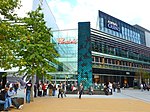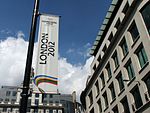Stratford Works
Former buildings and structures in the London Borough of NewhamGreat Eastern RailwayHistory of rail transport in LondonRailway depots in LondonRailway workshops in Great Britain ... and 3 more
Stratford, LondonTransport in the London Borough of NewhamUse British English from December 2017

Stratford Works was the locomotive-building works of the Great Eastern Railway situated at Stratford, London, England. The original site of the works was located in the 'V' between the Great Eastern Main Line and the Stratford to Lea Bridge route and in the early years was also the home of Stratford Locomotive Depot. The final part of the works closed in 1991. Overall Stratford works built 1,702 locomotives; 5,500 passenger vehicles and 33,000 goods wagons (although a significant number of these were built at the nearby Temple Mills wagon works when wagon building moved from the Stratford site in 1896).
Excerpt from the Wikipedia article Stratford Works (License: CC BY-SA 3.0, Authors, Images).Stratford Works
International Square, London Stratford Marsh (London Borough of Newham)
Geographical coordinates (GPS) Address Nearby Places Show on map
Geographical coordinates (GPS)
| Latitude | Longitude |
|---|---|
| N 51.5442 ° | E -0.0096 ° |
Address
Car Park A (Yellow) (Car Park A & B Westfield Stratford City)
International Square
E20 1EE London, Stratford Marsh (London Borough of Newham)
England, United Kingdom
Open on Google Maps










